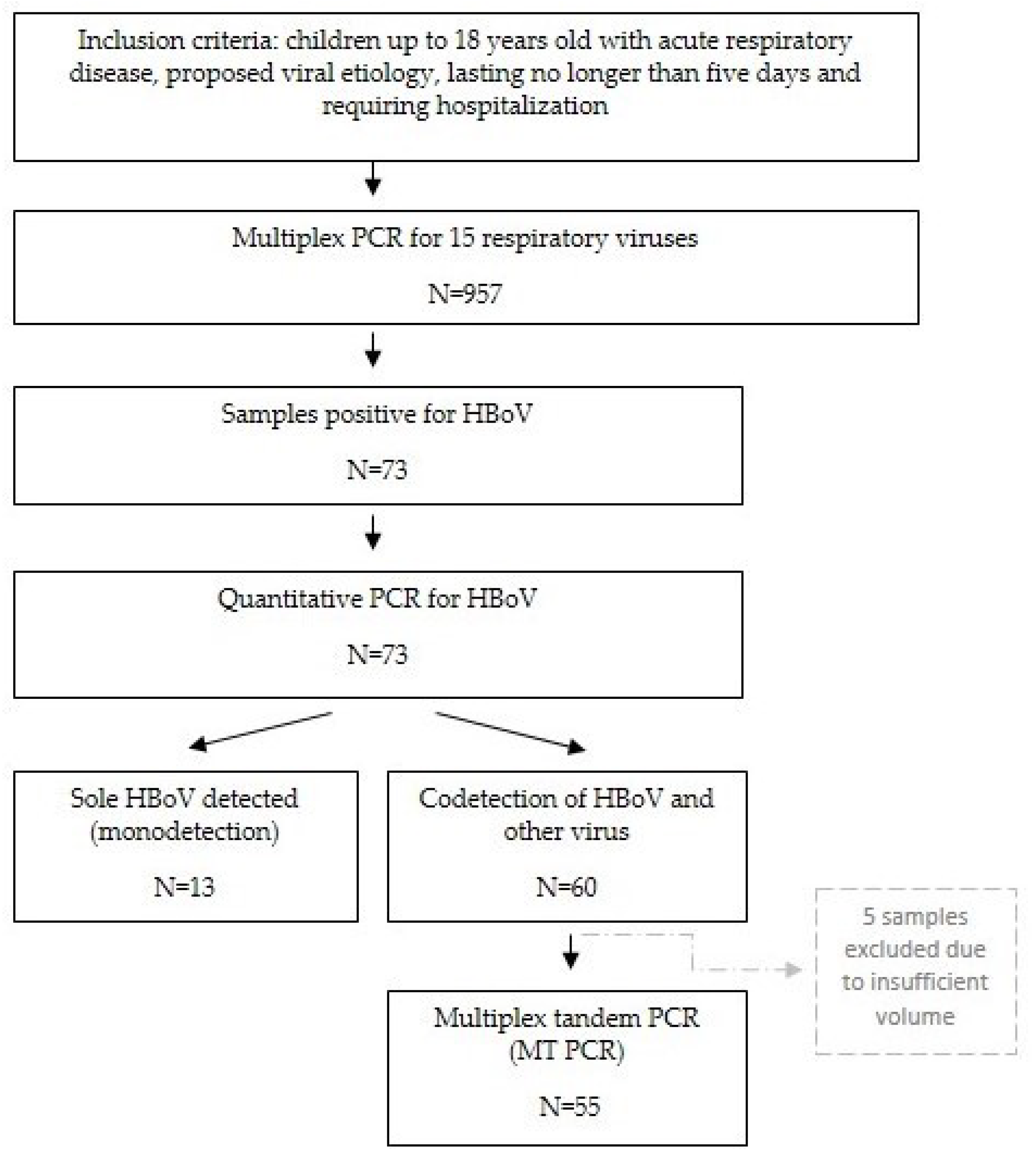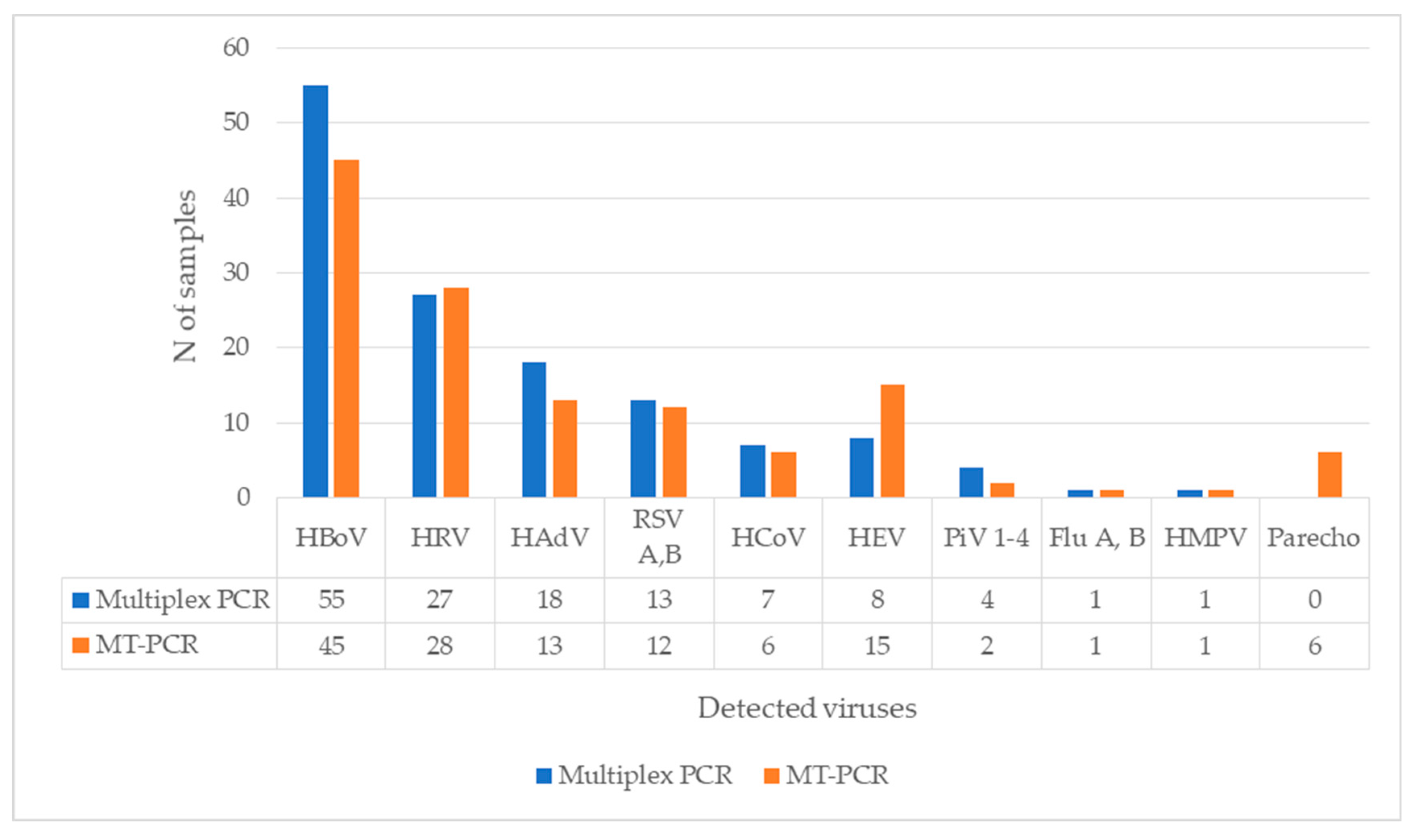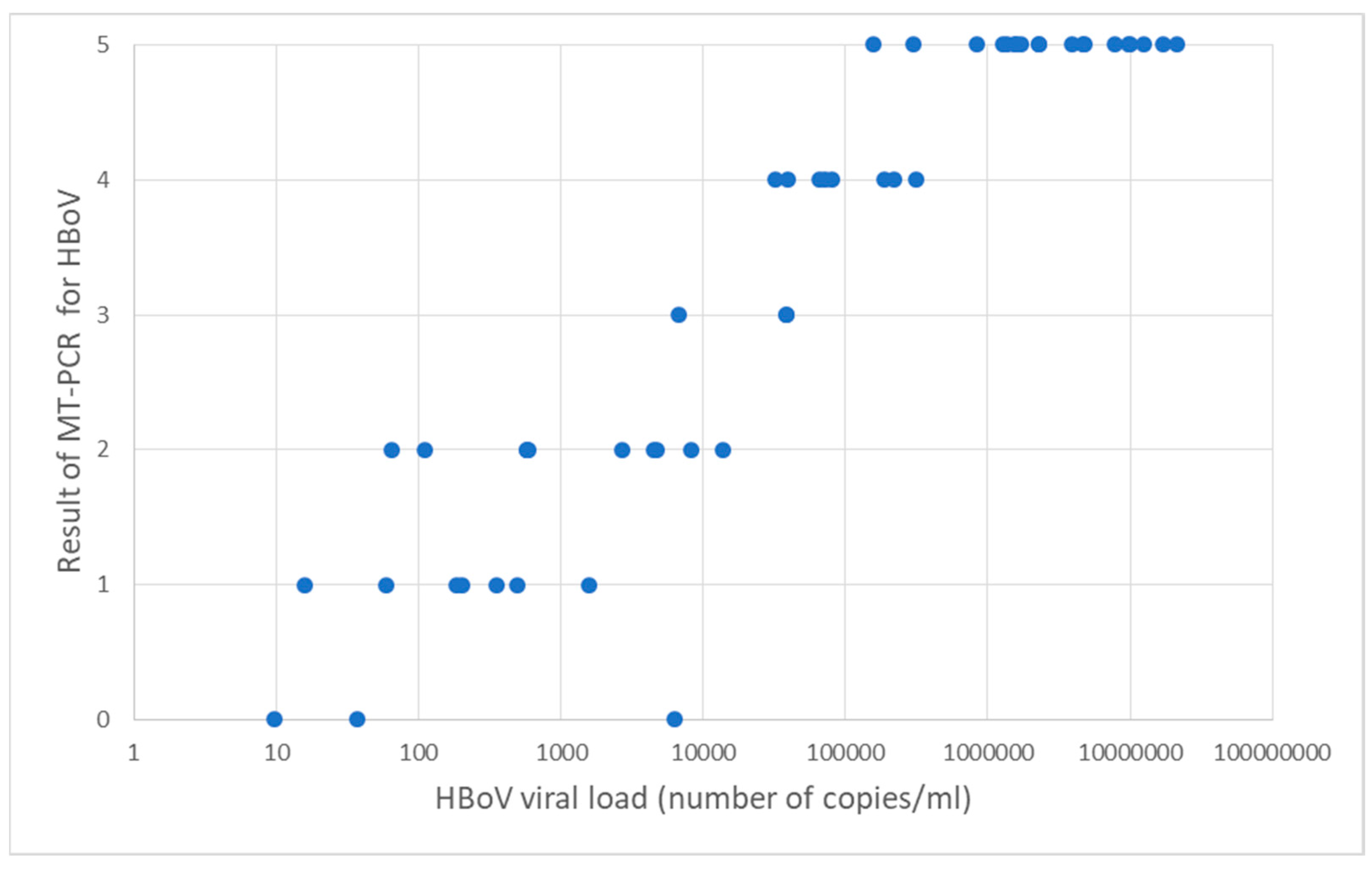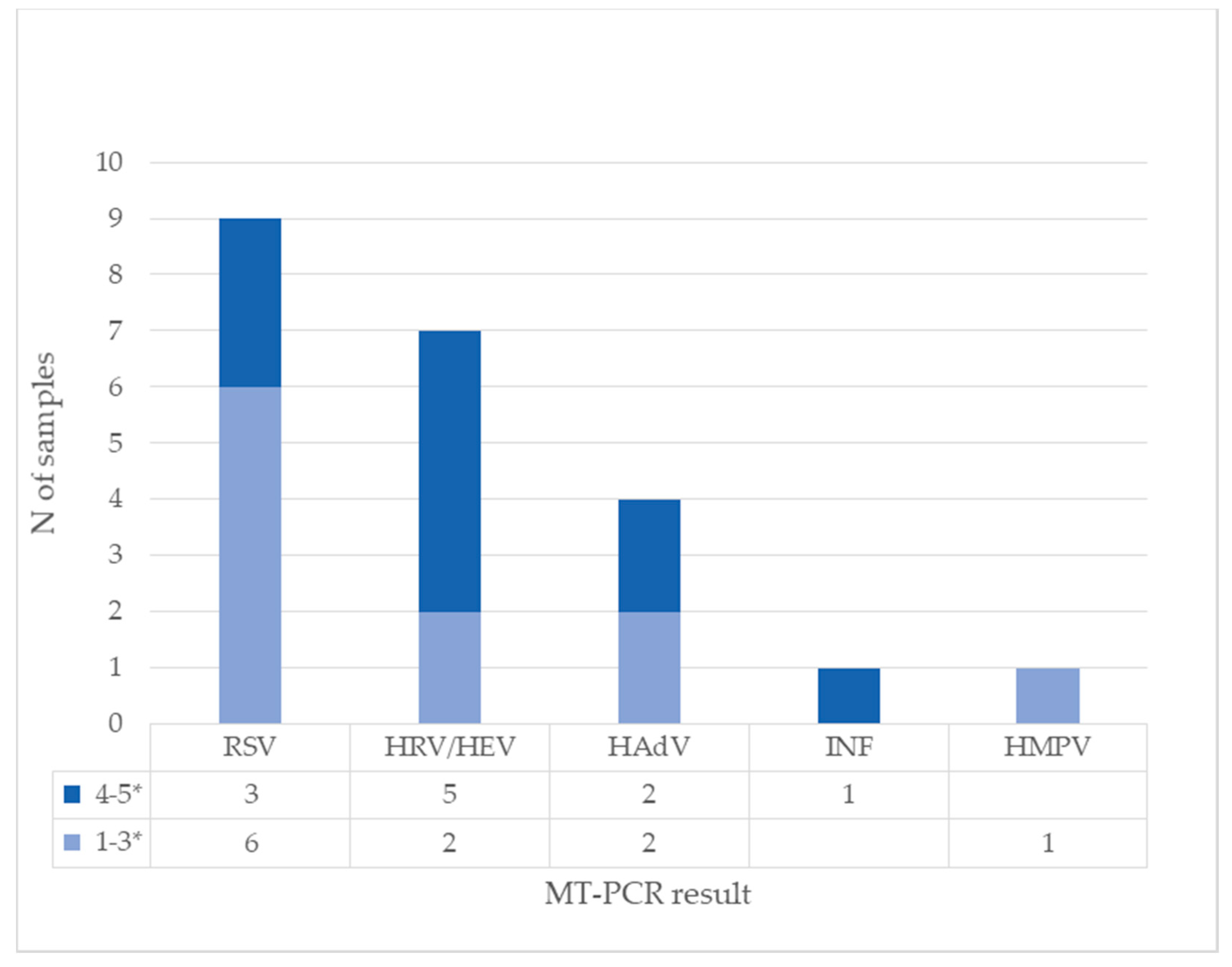Comparison of MT-PCR with Quantitative PCR for Human Bocavirus in Respiratory Samples with Multiple Respiratory Viruses Detection
Abstract
1. Introduction
2. Materials and Methods
2.1. Inclusion Criteria and Sample Collection
2.2. Multiplex PCR for 15 Respiratory Viruses
2.3. Quantitative PCR for HBoV
2.4. Multiplex Tandem PCR
2.5. Clinical Data Collection
3. Results
3.1. Multiplex PCR Results
3.2. Quantitative PCR Results
3.3. Comparison between Multiplex PCR and MT-PCR
3.4. Comparison of Quantitative PCR for HBoV and MT PCR
3.5. Characterization of Co-Detections and Comparison of the Amount of HBoV and Other Viruses
3.6. Clinical Relevance of Different Amounts of HBoV in Cases of Co-Detection
- A-
- Samples with a high concentration of HBoV (more than 104 copies/mL in quantitative PCR) and a high score of other viruses (intensity 4–5 stars on MT-PCR);
- B-
- Samples with a high concentration of HBoV (more than 104 copies/mL in quantitative PCR of and a low score of other viruses (intensity 1–3 stars on MT-PCR);
- C-
- Low concentration of HBoV (less than 104 copies/mL in quantitative PCR) or negative and high score of other viruses (intensity 4–5 stars on MT-PCR);
- D-
- Low concentration of HBoV (less than 104 copies/mL in quantitative PCR) or negative and low score of other viruses (intensity 1–3 stars on MT-PCR).
4. Discussion
Author Contributions
Funding
Institutional Review Board Statement
Informed Consent Statement
Data Availability Statement
Acknowledgments
Conflicts of Interest
References
- Allander, T.; Tammi, M.T.; Eriksson, M.; Bjerkner, A.; Tiveljung-Lindell, A.; Andersson, B. Cloning of a human parvovirus by molecular screening of respiratory tract samples. Proc. Natl. Acad. Sci. USA 2005, 102, 12891–12896, Erratum in Proc. Natl. Acad. Sci. USA 2005, 102, 15712. [Google Scholar] [CrossRef] [PubMed]
- Guido, M.; Tumolo, M.R.; Verri, T.; Romano, A.; Serio, F.; De Giorgi, M.; De Donno, A.; Bagordo, F.; Zizza, A. Human bocavirus: Current knowledge and future challenges. World J. Gastroenterol. 2016, 22, 8684–8697. [Google Scholar] [CrossRef] [PubMed]
- Christensen, A.; Kesti, O.; Elenius, V.; Eskola, A.L.; Døllner, H.; Altunbulakli, C.; Akdis, C.A.; Söderlund-Venermo, M.; Jartti, T. Human bocaviruses and paediatric infections. Lancet Child Adolesc. Health 2019, 3, 418–426. [Google Scholar] [CrossRef]
- Petrarca, L.; Nenna, R.; Frassanito, A.; Pierangeli, A.; Di Mattia, G.; Scagnolari, C.; Midulla, F. Human bocavirus in children hospitalized for acute respiratory tract infection in Rome. World J. Pediatr. 2020, 16, 293–298. [Google Scholar] [CrossRef] [PubMed]
- Meriluoto, M.; Hedman, L.; Tanner, L.; Simell, V.; Mäkinen, M.; Simell, S.; Mykkänen, J.; Korpelainen, J.; Ruuskanen, O.; Ilonen, J.; et al. Association of humanbocavirus 1 infection with respiratory disease in childhoodfollow-up study, Finland. Emerg. Infect. Dis. 2012, 18, 264–271. [Google Scholar] [CrossRef]
- Allander, T.; Jartti, T.; Gupta, S.; Niesters, H.G.; Lehtinen, P.; Osterback, R.; Vuorinen, T.; Waris, M.; Bjerkner, A.; Tiveljung-Lindell, A.; et al. Human bocavirus and acute wheezing in children. Clin. Infect. Dis. 2007, 44, 904–910. [Google Scholar] [CrossRef]
- Nokso-Koivisto, J.; Pyles, R.B.; Miller, A.L.; Jennings, K.; Loeffelholz, M.; Chonmaitree, T. Role of Human Bocavirus in Upper Respiratory Tract Infections and Acute Otitis Media. J. Pediatr. Infect. Dis. Soc. 2014, 3, 98–103. [Google Scholar] [CrossRef]
- Martin, E.T.; Fairchok, M.P.; Kuypers, J.; Magaret, A.; Zerr, D.M.; Wald, A.; Englund, J.A. Frequent and prolonged shedding of bocavirus in young children attending daycare. J. Infect. Dis. 2010, 201, 1625–1632. [Google Scholar] [CrossRef]
- Wagner, J.C.; Pyles, R.B.; Miller, A.L.; Nokso-Koivisto, J.; Loeffelholz, M.J.; Chonmaitree, T. Determining Persistence of Bocavirus DNA in the Respiratory Tract of Children by Pyrosequencing. Pediatr. Infect. Dis. J. 2016, 35, 471–476. [Google Scholar] [CrossRef]
- Wang, Z.; Shen, W.; Cheng, F.; Deng, X.; Engelhardt, J.F.; Yan, Z.; Qiu, J. Parvovirus Expresses a Small Noncoding RNA That Plays an Essential Role in Virus Replication. J. Virol. 2017, 91, e02375-16. [Google Scholar] [CrossRef]
- Jartti, T.; Hedman, K.; Jartti, L.; Ruuskanen, O.; Allander, T.; Söderlund-Venermo, M. Human bocavirus-the first 5 years. Rev. Med. Virol. 2012, 22, 46–64. [Google Scholar] [CrossRef] [PubMed]
- Kantola, K.; Sadeghi, M.; Antikainen, J.; Kirveskari, J.; Delwart, E.; Hedman, K.; Söderlund-Venermo, M. Real-time quantitative PCR detection of four human bocaviruses. J. Clin. Microbiol. 2010, 48, 4044–4050, Erratum in J. Clin. Microbiol. 2011, 49, 4029. [Google Scholar] [CrossRef] [PubMed]
- Kantola, K.; Hedman, L.; Tanner, L.; Simell, V.; Mäkinen, M.; Partanen, J.; Sadeghi, M.; Veijola, R.; Knip, M.; Ilonen, J.; et al. B-Cell Responses to Human Bocaviruses 1-4: New Insights from a Childhood Follow-Up Study. PLoS ONE 2015, 10, e0139096. [Google Scholar] [CrossRef] [PubMed]
- Jiang, W.; Yin, F.; Zhou, W.; Yan, Y.; Ji, W. Clinical significance of different virus load of human bocavirus in patients with lower respiratory tract infection. Sci. Rep. 2016, 6, 20246. [Google Scholar] [CrossRef] [PubMed]
- Söderlund-Venermo, M.; Lahtinen, A.; Jartti, T.; Hedman, L.; Kemppainen, K.; Lehtinen, P.; Allander, T.; Ruuskanen, O.; Hedman, K. Clinical assessment and improved diagnosis of bocavirus-induced wheezing in children, Finland. Emerg. Infect. Dis. 2009, 15, 1423–1430. [Google Scholar] [CrossRef] [PubMed]
- Stanley, K.K.; Szewczuk, E. Multiplexed tandem PCR: Gene profiling from small amounts of RNA using SYBR Green detection. Nucleic Acids Res. 2005, 33, e180. [Google Scholar] [CrossRef]
- Koskenvuo, M.; Möttönen, M.; Waris, M.; Allander, T.; Salmi, T.T.; Ruuskanen, O. Human bocavirus in children with acute lymphoblastic leukemia. Eur. J. Pediatr. 2008, 167, 1011–1015. [Google Scholar] [CrossRef] [PubMed]
- Ljubin-Sternak, S.; Slović, A.; Mijač, M.; Jurković, M.; Forčić, D.; Ivković-Jureković, I.; Tot, T.; Vraneš, J. Prevalence and Molecular Characterization of Human Bocavirus Detected in Croatian Children with Respiratory Infection. Viruses 2021, 13, 1728. [Google Scholar] [CrossRef]
- Polo, D.; Lema, A.; Gándara, E.; Romalde, J.L. Prevalence of human bocavirus infections in Europe. A systematic review and meta-analysis. Transbound. Emerg. Dis. 2022, 69, 2451–2461. [Google Scholar] [CrossRef]
- Blessing, K.; Neske, F.; Herre, U.; Kreth, H.W.; Weissbrich, B. Prolonged detection of human bocavirus DNA in nasopharyngeal aspirates of children with respiratory tract disease. Pediatr. Infect. Dis. J. 2009, 28, 1018–1019. [Google Scholar] [CrossRef]
- Martin, E.T.; Kuypers, J.; McRoberts, J.P.; Englund, J.A.; Zerr, D.M. Human Bocavirus 1 Primary Infection and Shedding in Infants. J. Infect. Dis. 2015, 212, 516–524. [Google Scholar] [CrossRef] [PubMed]
- Xu, M.; Perdomo, M.F.; Mattola, S.; Pyöriä, L.; Toppinen, M.; Qiu, J.; Vihinen-Ranta, M.; Hedman, K.; Nokso-Koivisto, J.; Aaltonen, L.M.; et al. Persistence of Human Bocavirus 1 in Tonsillar Germinal Centers and Antibody-Dependent Enhancement of Infection. MBio 2021, 12, e03132-20. [Google Scholar] [CrossRef] [PubMed]
- Xu, M.; Arku, B.; Jartti, T.; Koskinen, J.; Peltola, V.; Hedman, K.; Söderlund-Venermo, M. Comparative Diagnosis of Human Bocavirus 1 Respiratory Infection with Messenger RNA Reverse-Transcription Polymerase Chain Reaction (PCR), DNA Quantitative PCR, and Serology. J. Infect. Dis. 2017, 215, 1551–1557. [Google Scholar] [CrossRef] [PubMed]
- Schlaberg, R.; Ampofo, K.; Tardif, K.D.; Stockmann, C.; Simmon, K.E.; Hymas, W.; Flygare, S.; Kennedy, B.; Blaschke, A.; Eilbeck, K.; et al. Human Bocavirus Capsid Messenger RNA Detection in Children with Pneumonia. J. Infect. Dis. 2017, 216, 688–696. [Google Scholar] [CrossRef]
- Proença-Modena, J.L.; Gagliardi, T.B.; Paula, F.E.; Iwamoto, M.A.; Criado, M.F.; Camara, A.A.; Acrani, G.O.; Cintra, O.A.; Cervi, M.C.; Arruda, L.K.; et al. Detection of human bocavirus mRNA in respiratory secretions correlates with high viral load and concurrent diarrhea. PLoS ONE 2011, 6, e21083. [Google Scholar] [CrossRef]
- Christensen, A.; Nordbø, S.A.; Krokstad, S.; Rognlien, A.G.; Døllner, H. Human bocavirus in children: Mono-detection, high viral load and viraemia are associated with respiratory tract infection. J. Clin. Virol. 2010, 49, 158–162. [Google Scholar] [CrossRef]
- Szewczuk, E.; Thapa, K.; Anninos, T.; McPhie, K.; Higgins, G.; Dwyer, D.E.; Stanley, K.K.; Iredell, J.R. Rapid semi-automated quantitative multiplex tandem PCR (MT-PCR) assays for the differential diagnosis of influenza-like illness. BMC Infect. Dis. 2010, 10, 113. [Google Scholar] [CrossRef]
- Esper, F.P.; Spahlinger, T.; Zhou, L. Rate and influence of respiratory virus co-infection on pandemic (H1N1) influenza disease. J. Infect. 2011, 63, 260–266. [Google Scholar] [CrossRef]
- Goka, E.A.; Vallely, P.J.; Mutton, K.J.; Klapper, P.E. Single and multiple respiratory virus infections and severity of respiratory disease: A systematic review. Paediatr. Respir Rev. 2014, 15, 363–370. [Google Scholar] [CrossRef]
- Mazur, N.I.; Bont, L.; Cohen, A.L.; Cohen, C.; von Gottberg, A.; Groome, M.J.; Hellferscee, O.; Klipstein-Grobusch, K.; Mekgoe, O.; Naby, F.; et al. South African Severe Acute Respiratory Illness (SARI) Surveillance Group. Severity of Respiratory Syncytial Virus Lower Respiratory Tract Infection with Viral Coinfection in HIV-Uninfected Children. Clin. Infect. Dis. 2017, 64, 443–450. [Google Scholar] [CrossRef]
- Zhao, B.; Yu, X.; Wang, C.; Teng, Z.; Wang, C.; Shen, J.; Gao, Y.; Zhu, Z.; Wang, J.; Yuan, Z.; et al. High human bocavirus viral load is associated with disease severity in children under five years of age. PLoS ONE 2013, 8, e62318. [Google Scholar] [CrossRef] [PubMed]
- Deng, Y.; Gu, X.; Zhao, X.; Luo, J.; Luo, Z.; Wang, L.; Fu, Z.; Yang, X.; Liu, E. High viral load of human bocavirus correlates with duration of wheezing in children with severe lower respiratory tract infection. PLoS ONE 2012, 7, e34353. [Google Scholar] [CrossRef]
- Moesker, F.M.; van Kampen, J.J.; van der Eijk, A.A.; van Rossum, A.M.; de Hoog, M.; Schutten, M.; Smits, S.L.; Bodewes, R.; Osterhaus, A.D.; Fraaij, P.L. Human bocavirus infection as a cause of severe acute respiratory tract infection in children. Clin. Microbiol. Infect. 2015, 21, 964.e1–964.e8. [Google Scholar] [CrossRef] [PubMed]
- Feikin, D.R.; Fu, W.; Park, D.E.; Shi, Q.; Higdon, M.M.; Baggett, H.C.; Brooks, W.A.; Deloria Knoll, M.; Hammitt, L.L.; Howie, S.R.C.; et al. Is Higher Viral Load in the Upper Respiratory Tract Associated With Severe Pneumonia? Findings From the PERCH Study. Clin. Infect. Dis. 2017, 64 (Suppl. S3), S337–S346. [Google Scholar] [CrossRef] [PubMed]
- Walter, J.M.; Wunderink, R.G. Severe Respiratory Viral Infections: New Evidence and Changing Paradigms. Infect. Dis. Clin. N. Am. 2017, 31, 455–474. [Google Scholar] [CrossRef] [PubMed]
- Self, W.H.; Williams, D.J.; Zhu, Y.; Ampofo, K.; Pavia, A.T.; Chappell, J.D.; Hymas, W.C.; Stockmann, C.; Bramley, A.M.; Schneider, E.; et al. Respiratory Viral Detection in Children and Adults: Comparing Asymptomatic Controls and Patients with Community-Acquired Pneumonia. J. Infect. Dis. 2016, 213, 584–591. [Google Scholar] [CrossRef] [PubMed]





| Multiplex PCR | HBoV Quantitative PCR (Number of Copies/mL) | MT-PCR | MT-PCR HBoV Intensity |
|---|---|---|---|
| HBoV, RSV B | 9.70 × 106 | HBoV | 5 |
| HBoV, PiV 4, AdV | 8.40 × 105 | HBoV | 5 |
| HBoV, PiV 4 | 2.03 × 102 | HBoV | 1 |
| HBoV, HRV | 5.86 × 102 | HBoV | 2 |
| Multiplex PCR | HBoV Quantitative PCR (Number of Copies/mL) | MT-PCR | MT-PCR Sample Adequacy |
|---|---|---|---|
| HBoV, HRV | 6.29 × 103 | RV/EV * | 3 |
| HBoV, HRV, RSV A | 37.1 | RSV | 4 |
| HBoV, HRV, HEV, HCoV | 9.71 | HCoV, RV/EV, EV * | 4 |
| HBoV, HRV | 0 | RV/EV * | 3 |
| HBoV, HEV, AdV | 0 | RV/EV, EV * | 5 |
| HBoV, HRV | 0 | RV/EV * | 3 |
| HBoV, HRV, AdV, PiV 1, PiV 4 | 0 | PiV 4 | 4 |
| HBoV, RSV A, HCoV | 0 | RSV, RV/EV * | 4 |
| HBoV, HRV, AdV | 0 | AdV | 4 |
| HBoV, AdV | 0 | 0 | 3 |
| Group | Quantitative PCR Concentration of HBoV | MT-PCR Intensity of Other Viruses | URTI (N of Patients) | LRTI (N of Patients) |
|---|---|---|---|---|
| A | high (more than 104 copies/mL) | 4–5 stars | 6 | 8 |
| B | high (more than 104 copies/mL) | 1–3 stars | 8 | 6 |
| C | low or negative (less than 104 copies/mL) | 4–5 stars | 5 | 9 |
| D | low or negative (less than 104 copies/mL) | 1–3 stars | 4 | 9 |
| Total | 23 | 32 |
Disclaimer/Publisher’s Note: The statements, opinions and data contained in all publications are solely those of the individual author(s) and contributor(s) and not of MDPI and/or the editor(s). MDPI and/or the editor(s) disclaim responsibility for any injury to people or property resulting from any ideas, methods, instructions or products referred to in the content. |
© 2023 by the authors. Licensee MDPI, Basel, Switzerland. This article is an open access article distributed under the terms and conditions of the Creative Commons Attribution (CC BY) license (https://creativecommons.org/licenses/by/4.0/).
Share and Cite
Mijač, M.; Ljubin-Sternak, S.; Ivković-Jureković, I.; Vraneš, J. Comparison of MT-PCR with Quantitative PCR for Human Bocavirus in Respiratory Samples with Multiple Respiratory Viruses Detection. Diagnostics 2023, 13, 846. https://doi.org/10.3390/diagnostics13050846
Mijač M, Ljubin-Sternak S, Ivković-Jureković I, Vraneš J. Comparison of MT-PCR with Quantitative PCR for Human Bocavirus in Respiratory Samples with Multiple Respiratory Viruses Detection. Diagnostics. 2023; 13(5):846. https://doi.org/10.3390/diagnostics13050846
Chicago/Turabian StyleMijač, Maja, Sunčanica Ljubin-Sternak, Irena Ivković-Jureković, and Jasmina Vraneš. 2023. "Comparison of MT-PCR with Quantitative PCR for Human Bocavirus in Respiratory Samples with Multiple Respiratory Viruses Detection" Diagnostics 13, no. 5: 846. https://doi.org/10.3390/diagnostics13050846
APA StyleMijač, M., Ljubin-Sternak, S., Ivković-Jureković, I., & Vraneš, J. (2023). Comparison of MT-PCR with Quantitative PCR for Human Bocavirus in Respiratory Samples with Multiple Respiratory Viruses Detection. Diagnostics, 13(5), 846. https://doi.org/10.3390/diagnostics13050846








